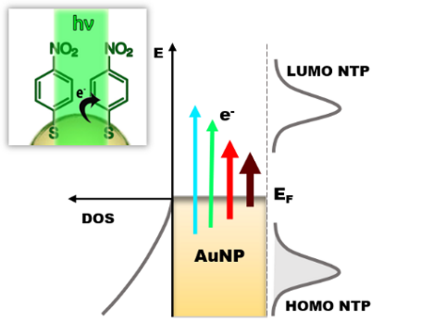Plasmon chemistry
Overview
Plasmonic nanoparticles such as gold or silver nanoparticles can trigger chemical processes in their environment upon excitation of their localized surface plasmon resonance. These processes can either be ascribed to the generation and transfer of hot charge carriers and/or to increased temperature. We study plasmon induced chemical reactions in a broad range of molecules such as halogenated nucleobases using surface-enhanced Raman scattering (SERS). Additionally, we employ synchrotron XPS to characterize the electronic structure of the metal-organic interface.
Selected publications
Plasmonic reactivity of halogen thiophenols on gold nanoparticles studied by SERS and XPS; R. Schürmann, A. Dutta, K. Ebel, K. Tapio, A. R. Milosavljević and I. Bald , J. Chem. Phys. 10.1063/5.0098110.
Controlling Plasmonic Chemistry Pathways through Specific Ion Effects; A. Stefancu, L. Nan, L. Zhu, V. Chiș, I. Bald, M. Liu, N. Leopold, S. A. Maier, E. Cortes , Adv. Opt. Mater. 2022, 2200397.
The electronic structure of the metal–organic interface of isolated ligand coated gold nanoparticles; R. Schürmann, E. Titov, K. Ebel, S. Kogikoski Jr., A. Mostafa, P. Saalfrank, A. R. Milosavljević and I. Bald, Nanoscale Adv., 2022, 4, 1599-1607.
Microscopic Understanding of Reaction Rates Observed in Plasmon Chemistry of Nanoparticle-Ligand Systems; R. Schürmann, A. Nagel, S. Juergemsen, A. Pathak, S. Reich, C. Pacholski and I. Bald, J. Phys. Chem. C 2022, 126, 11, 5333-5342.
Spatial Separation of Plasmonic Hot-Electron Generation and a Hydrodehalogenation Reaction Center Using a DNA Wire; S. Kogikoski Jr., A. Dutta and I. Bald, ACS Nano 2021, 15, 20562.
The Role of Structural Flexibility in Plasmon-Driven Coupling Reactions: Kinetic Limitations in the Dimerization of Nitro-Benzenes; W. Koopmann, E. Titov, R. M. Sarhan, T. Gaebel, R. Schürmann, A. Mostafa, S. Kogikoski Jr., A. R. Milosavljević, F. Stete, F. Liebig, C. N. Z. Schmitt, J. Koetz, I. Bald, P. Saalfrank and M. Bargheer, Adv. Mater. Interfaces 2021, 8, 2101344
Kinetics and Mechanism of Plasmon-Driven Dehalogenation Reaction of Brominated Purine Nucleobases on Ag and Au; A. Dutta, R. Schürmann, S. Kogikoski Jr., N. S. Mueller, S. Reich and I. Bald, ACS Catal. 2021, 11 (13), 8370-8381.
Decomposition of halogenated nucleobases by surface plasmon resonance excitation of gold nanoparticles; T. S. Marques, M. Śmiałek, R. Schürmann, I. Bald, M. Raposo, S. Eden N. Mason Eur. Phys. J. D 74, 222 (2020)
Interaction of 4-Nitrothiophenol with low energy electrons - Implications for plasmon mediated reactions; R. Schürmann, T. F. M. Luxford, I. Vinklarek, J. Kocisek, M. Zawadzki and I. Bald J. Chem. Phys. 2020, 153, 104303.
Kinetics of molecular decomposition under irradiation of gold nanoparticles with nanosecond laser pulses - A 5-Bromouracil case study; T. S. Marques, R. Schürmann, K. Ebel, C. Heck, M. Śmiałek, S. Eden, N. Mason and I. Bald; J. Chem. Phys. 2020, 152, 124712.
Plasmon mediated decomposition of brominated nucleobases on silver nanoparticles - A surface enhanced Raman scattering (SERS) study; A. Dutta, R. Schürmann and I. Bald; Eur. Phys. J. D, 2020, 74, 19.
Role of Valence Band States and Plasmonic Enhancement in Electron-Transfer-Induced Transformation of Nitrothiophenol; R. Schürmann, K. Ebel, C. Nicolas, A. R. Milosavljevic, I. Bald; J. Phys. Chem. Lett. 2019, 10, 3153-3158.
Amorphous Carbon Generation as a Photocatalytic Reaction on DNA-Assembled Gold and Silver Nanostructures; C. Heck, Y. Kanehira, J. Kneipp, I. Bald, Molecules 2019, 24, 2324.
Real-time monitoring of plasmon induced dissociative electron transfer to the potential DNA radiosensitizer 8-bromoadenine; R. Schürmann, I. Bald, Nanoscale 2017, 9, 1951.
PhD theses completed on this topic
Dr. Robin Schürmann: Interaction of the potential DNA-radiosensitizer 8-bromoadenine with free and plasmonically generated electrons

